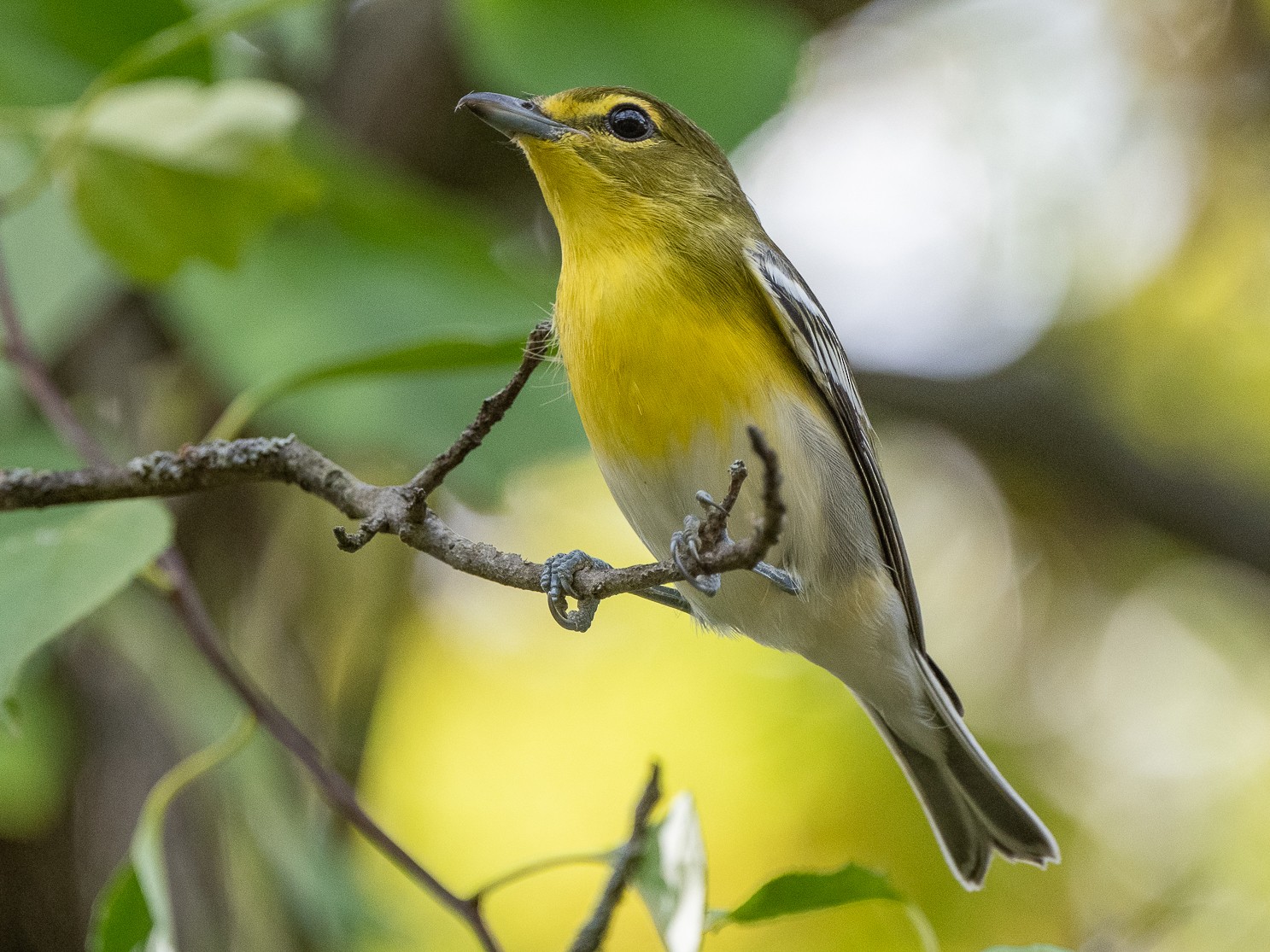In New York, when spring and summer arrive, it’s a common sight to see yellow birds, particularly warblers and orioles. However, during the winter season, the American Goldfinch is the predominant yellow bird found in the area.
To assist you in identifying these yellow birds in New York, this guide provides you with pictures, identification information, song recordings, and details about their migration patterns.
Most of the yellow birds in New York belong to the warbler, oriole, or tanager families. Additionally, some female birds within these species exhibit distinct appearances compared to their male counterparts.
By utilizing the information presented in this guide, identifying yellow birds in New York will become a much simpler task. The guide lists these birds in order of their frequency of sightings in New York during the spring and summer months (May and June) based on ebird checklists.
Yellow birds present in New York throughout the year include the American Goldfinch and the Yellow-rumped Warbler. During the summer, you can also spot Common Yellowthroats, Cedar Waxwings, Yellow Warblers, Baltimore Orioles, American Redstarts, Scarlet Tanagers, Black-throated Green Warblers, Magnolia Warblers, Pine Warblers, Blue-winged Warblers, Nashville Warblers, Yellow-throated Vireos, Eastern Meadowlarks, Prairie Warblers, Canada Warblers, Hooded Warblers, Orchard Orioles, White-eyed Vireos, Prothonotary Warblers, and Yellow-throated Warblers. In the winter, the Evening Grosbeak can be observed. During migration, watch out for Palm Warblers, Cape May Warblers, Wilson’s Warblers, Orange-crowned Warblers, Dickcissels, and Summer Tanagers.
Continue reading this guide to identify the yellow birds you’ve spotted. It provides detailed information about each species.
29 Yellow Birds in New York:
1. American Goldfinch
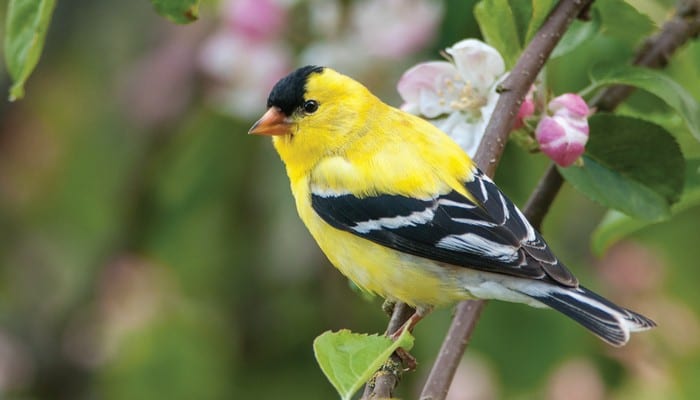
Throughout the year, American Goldfinches can be found in New York. However, their population increases during the breeding season, from May to September. In summer checklists, they are observed in 44% of cases, and in winter checklists, they are noted in 24% of submissions by birdwatchers.
American Goldfinches are highly sought-after birds, especially due to the vibrant yellow and black plumage of the males during spring. In contrast, females exhibit a duller brown coloration, resembling the appearance of males during winter.
- Spinus tristis
- Length: 4.3-5.1 inches (11-13 cm)
- Weight: 0.4-0.7 ounces (11-20 g)
- Wingspan: 7.5-8.7 inches (19-22 cm)
American Goldfinches are distributed across most of North America and typically reside in these regions year-round. However, those breeding in Canada and the Midwest migrate to southern US states for the winter.
You can spot American Goldfinches in weedy fields, overgrown areas, suburbs, parks, and even in backyards while they forage for sunflower, thistle, and aster plants.
American Goldfinch Song:
Their nests are usually situated in shrubs and constructed using rootlets, plant material, and spider webs to secure them to branches. They lay up to seven eggs, which take around two weeks to hatch. The young birds then remain in the nest for approximately two to two and a half weeks before venturing out.
To attract American Goldfinches to your backyard, consider planting thistles and milkweed. These birds are known to visit various bird feeders, and they have a preference for sunflower and nyjer seeds.
Fun Fact: Cowbirds have little success in persuading American Goldfin
ches to raise their young, as the finches’ vegetarian diet is unsuitable for cowbird chicks, leading to their demise within a few days.
2. Common Yellowthroat

During the breeding season, Common Yellowthroats can be found in New York, primarily from May to November. They appear in approximately 32% of summer checklists.
Common Yellowthroats are small songbirds characterized by their brownish back and vibrant yellow underparts. They possess long tails and distinctive black masks across their faces. It’s worth noting that the intensity of their yellow plumage may vary geographically, with some individuals exhibiting a more olive hue underneath.
- Geothlypis trichas
- Length: 4.3-5.1 inches (11-13 cm)
- Weight: 0.3-0.3 ounces (9-10 g)
- Wingspan: 5.9-7.5 inches (15-19 cm)
Throughout the summer, Common Yellowthroats breed across most of North America, excluding Alaska and northern Canada. Some individuals remain year-round along the Gulf Coast and Pacific Southwest. During the winter, they migrate south to warmer regions.
Common Yellowthroats are commonly found in marshy or wetland areas, as well as brushy fields with dense vegetation.
Common Yellowthroat Song:
Credit: Paul Marvin, XC629250. Accessible at www.xeno-canto.org/629250.
Females construct their nests near the ground in marshy regions, using reeds for support. The nests are made from grass, sedges, leaves, and other plant materials, forming a cup-shaped structure. They lay up to six eggs, which require approximately twelve days to hatch. The young birds leave the nest after a similar period.
To attract Common Yellowthroats to larger backyards, consider providing dense vegetation and native plants that can attract insects.
Fun Fact: The black mask of Common Yellowthroats serves as a visual cue to courting males, signaling their gender and leading to aggressive behaviors when fake birds without masks are introduced. However, these attacks cease when birds lacking masks are used.
3. Cedar Waxwing

Cedar Waxwings can be spotted in New York throughout the year, with a higher frequency of sightings in the northern regions during the breeding season (May to November). They appear in 20% of summer checklists and 1% of winter checklists.
Cedar Waxwings are elegant and sociable birds, characterized by their pale brown heads, chests, and crests, which transition to a gray color on their backs, wings, and tails. Their bellies exhibit a pale yellow hue, and their wings boast bright red tips. Additionally, they possess a narrow black mask extending over their eyes.
- Bombycilla cedrorum
- Length: 5.5-6.7 inches (14-17 cm)
- Weight: 1.1 ounces (32 g)
- Wingspan: 8.7-11.8 inches (22-30 cm)
Cedar Waxwings breed in Canada before migrating to southern US states, Mexico, Central America, and other regions for the winter. However, they remain resident throughout the year in the northern states of the US.
These birds can be observed in berry bushes, woodlands, grasslands, towns, and near streams. They primarily feed on fruit, but they also consume insects during the summer season.
Cedar Waxwing Call:
Credit: Peter Ward and Ken Hall, XC512254. Accessible at www.xeno-canto.org/512254.
Nests of Cedar Waxwings are constructed using twigs, grass, hair, and various plant materials. The nests are lined with pine needles and soft grass. During nesting, they lay up to six eggs, which
require around twelve days to hatch. The young birds leave the nest within approximately sixteen days.
To attract Cedar Waxwings to your backyard, consider planting native trees and shrubs that produce small fruits such as serviceberry, dogwood, juniper, winterberry, and hawthorn. You can also try offering fruit on platform feeders.
Fun Fact: Cedar Waxwings engage in a unique behavior of sharing gifts during courtship, passing items between each other as part of their mating rituals.
4. Yellow Warbler

Yellow Warblers can be spotted in New York during the breeding season, typically arriving in April and beginning their migration in October. They are observed in approximately 33% of summer checklists.
These small, bright yellow birds have a yellow-green back, and male individuals display chestnut streaks on their breasts. In contrast, females and juveniles have a less vibrant appearance compared to males.
- Setophaga petechia
- Length: 4.7-5.1 inches (12-13 cm)
- Weight: 0.3-0.4 ounces (9-11 g)
- Wingspan: 6.3-7.9 inches (16-20 cm)
Yellow Warblers undertake extensive migrations, breeding in Canada and the United States (except for southeastern states) before migrating to Central and South America for the winter. During their migration, they can be seen in southeastern US states.
These birds can be found along streams, wetlands, and thickets, foraging for insects such as caterpillars, midges, beetles, bugs, and wasps.
Yellow Warbler Song:
Credit: Richard E. Webster, XC662546. Accessible at www.xeno-canto.org/662546.
Nests of Yellow Warblers are typically built in small trees or shrubs using bark, grass, and plant material woven together and secured with spider webs. The nests are then lined with softer materials like hair, feathers, and plant down. They lay up to seven eggs, which take around twelve days to hatch, followed by an additional ten days for the young birds to leave the nest.
To attract Yellow Warblers to your backyard, consider providing suet, oranges, peanut butter, and plants with berries. Planting native plants that attract insects without the use of pesticides and maintaining a less tidy garden can also be beneficial. Additionally, birdbaths with fountains placed near secluded plantings can provide protection and water sources.
Fun Fact: When Cowbirds lay their eggs in Yellow Warblers’ nests, the Yellow Warblers often build a new nest on top of the old one, repeating this process multiple times (up to six) to avoid raising the cowbird chicks.
5. Yellow-rumped Warbler
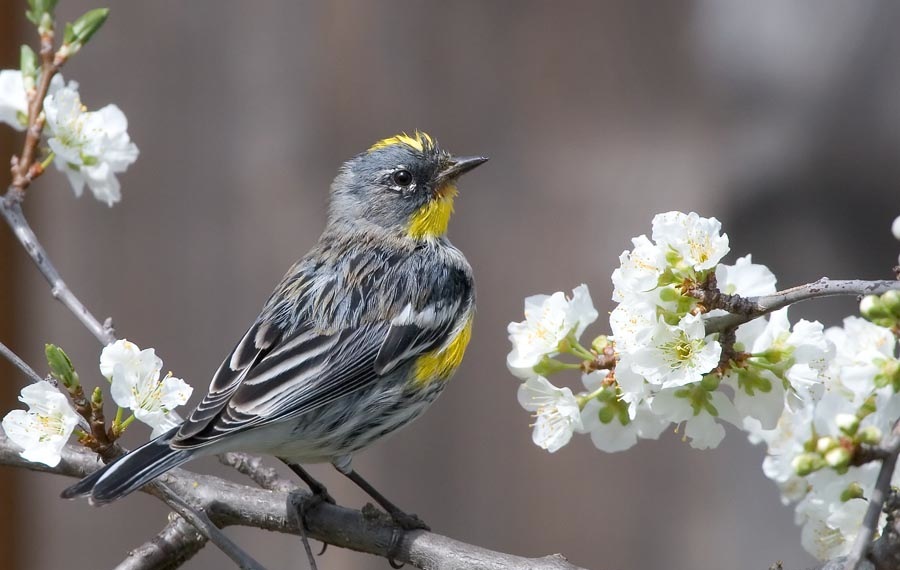
Yellow-rumped Warblers can be observed in New York throughout the year, but their numbers increase during migration periods in April to May and September to November. They are recorded in up to 37% of checklists during migration.
These warblers display gray plumage with flashes of yellow on their faces, sides, and rumps. Their wings are white, and females may have a slightly brownish hue. In winter, they exhibit paler brown coloration with bright yellow rumps and sides, which transition back to yellow and gray in spring.
- Setophaga coronata
- Length: 4.7-5.5 inches (12-14 cm)
- Weight: 0.4-0.5 ounces (12-13 g)
- Wingspan: 7.5-9.1 inches (19-23 cm)
Yellow-rumped Warblers primarily breed in Canada, the Rockies, and the Appalachian mountains. During migration, they can be seen in the Midwest before overwintering in southern and southwestern US states, the Pacific Coast, Mexico, and Central America.
These birds can be found in coniferous forests, especially during the breeding season. In winter, they can be spotted in open areas with fruiting shrubs. Their diet consists mainly of insects during the summer season, while they rely more on fruit, including bayberry and wax myrtle, during migration and winter.
Yellow-rumped Warbler Song:
Credit: Christopher McPherson, XC602699. Accessible at www.xeno-canto.org/602699.
Nests of Yellow-rumped Warblers are built by females in conifer trees using twigs, pine needles, grass, and other materials. The nests are lined with soft grass, moss, and hair. They lay up to six eggs, which take around two weeks to hatch, followed by another two weeks for the young birds to leave the nest.
To attract Yellow-rumped Warblers to your backyard, consider offering sunflower seeds, suet, raisins, and peanut butter.
Fun Fact: Yellow-rumped Warblers form large flocks numbering in the thousands during the winter, and they can exhibit aggression towards other bird species that come too close.
6. Baltimore Oriole Female
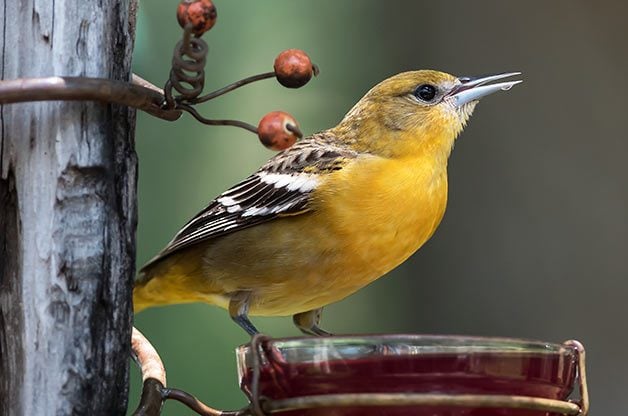
Baltimore Orioles spend the breeding season in New York and are primarily seen from May to mid-October, appearing in approximately 28% of summer checklists.
These birds are a colorful sight during spring in the eastern part of North America. Adult male Baltimore Orioles display bright orange and black plumage, accompanied by white wing bars on their black wings.
Female Baltimore Orioles have a yellowish hue on their undersides and heads, with grayish-brown wings and brownish-yellow backs. They are slightly smaller and more slender than robins, belonging to the blackbird family.
- Icterus galbula
- Length: 6.7-7.5 inches (17-19 cm)
- Weight: 1.1-1.4 ounces (30-40 g)
- Wingspan: 9.1-11.8 inches (23-30 cm)
Baltimore Orioles breed in the eastern and central states of the US, including central-southern Canadian provinces and the southern US border regions.
During winter, Baltimore Orioles migrate to Florida, Central America, and the Caribbean, typically departing as early as July.
These birds can be found high up in open woodlands, along riverbanks, and at forest edges, where they forage for insects and fruit. They are known to frequent parks and backyards as well.
The diet of Baltimore Orioles primarily consists of insects such as beetles, crickets, grasshoppers, spiders, and snails. They also feed on a wide variety of fruits, although they can cause damage to crops such as raspberries, mulberries, cherries, bananas, and oranges.
Baltimore Oriole Sounds: The flute-like song of Baltimore Orioles is a delightful feature of spring. They also produce chattering and sharp alarm calls.
Christopher McPherson, XC690956. Accessible at www.xeno-canto.org/690956.
To attract Baltimore Orioles to your backyard, try offering halved oranges on a platform feeder or hanging them from trees. Oriole feeders filled with sugar water can also be effective. Planting fruiting plants and nectar-rich flowers like raspberries, crab apples, and trumpet vines will provide additional attractions.
Fun Fact: Baltimore Orioles construct incredible hanging bag-like nests woven from fibers.
7. American Redstart Female

American Redstarts spend the breeding season in New York and can be observed mainly from mid-April to October, with some individuals remaining until early January. They appear in approximately 17% of summer checklists.
Male American Redstarts display a predominantly black plumage with bright orange patches and a white belly. Females, on the other hand, exhibit an olive-gray coloration instead of black and possess numerous yellow patches.
- Setophaga ruticilla
- Length: 4.3-5.1 inches (11-13 cm)
- Weight: 0.2-0.3 ounces (6-9 g)
- Wingspan: 6.3-7.5 inches (16-19 cm)
American Redstarts breed in eastern US states, parts of Canada, and northwestern US states.
They may also be observed during migration in central and western US regions.
These birds can be found in deciduous woodlands, backyards, and thickets, where they feed on insects. They also consume berries such as serviceberry and magnolia.
American Redstart Song:
Credit: Nick Kiehl, XC522368. Accessible at www.xeno-canto.org/522368.
Nests of American Redstarts are located near the trunk of trees or large shrubs and are constructed using bark, grass, and other plant materials. The nests are lined with soft grass, pine needles, and other gentle materials. They lay up to five eggs, which require just under two weeks to hatch, followed by approximately one to two weeks for the young birds to leave the nest.
To attract American Redstarts to your backyard, provide berry-producing plants like magnolia and serviceberry.
Fun Fact: American Redstart parents selectively feed specific chicks, rather than providing food to all of them uniformly.
8. Scarlet Tanager Female

Scarlet Tanagers can be observed during the summer season in New York, appearing in approximately 10% of checklists. They are primarily seen from April to mid-October, with a few individuals lingering until December.
Female Scarlet Tanagers display a yellow coloration with darker wings and tails, similar to the appearance of post-molt male individuals.
Male Scarlet Tanagers are striking red birds with black wings and tails. They possess thick bills and relatively short tails.
- Piranga olivacea
- Length: 6.3-6.7 inches (16-17 cm)
- Weight: 0.8-1.3 ounces (23-38 g)
- Wingspan: 9.8-11.4 inches (25-29 cm)
During the summer, Scarlet Tanagers breed in eastern forests before migrating to western South America. They can be observed during migration in southeastern US states.
Scarlet Tanagers tend to stay high in the forest canopy, making them somewhat challenging to spot. However, one may catch a glimpse of their red plumage as they move along branches in search of insects.
Scarlet Tanager Song:
Credit: Christopher McPherson, XC599850. Accessible at www.xeno-canto.org/599850.
Nests of Scarlet Tanagers are loosely constructed from twigs, grass, and weeds, placed close to the trunk of trees. The interiors are lined with soft grass, pine needles, and other gentle materials. They lay around four eggs, requiring approximately twelve days to hatch, followed by an additional week or two for the young birds to fledge.
To attract Scarlet Tanagers, consider planting berry-producing plants such as blackberries, raspberries, huckleberries, juneberries, serviceberries, mulberries, strawberries, and chokeberries.
Fun Fact: Male Scarlet Tanagers engage in singing battles, sometimes leading to actual physical fights.
9. Black-throated Green Warbler
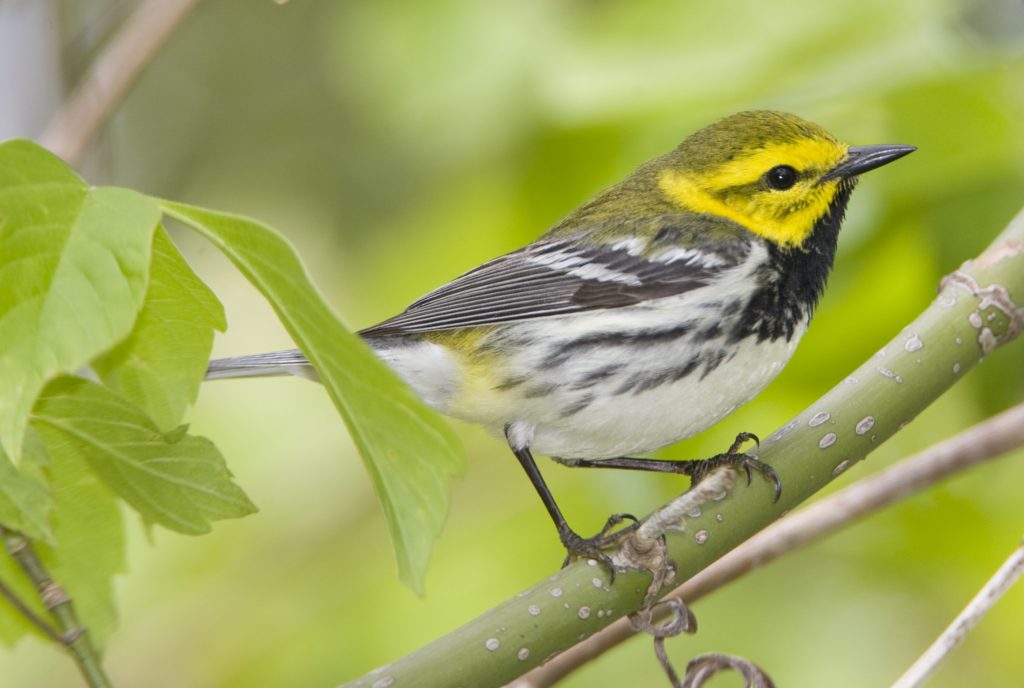
Black-throated Green Warblers can be spotted in New York during the breeding season, with increased sightings during migration in May and September. They are recorded in approximately 8% of summer checklists and up to 15% of checklists during migration.
These warblers feature small bodies with yellow plumage and a yellow face and head. They have an olive-yellow back and black streaking on the sides and wings. Male individuals possess larger black patches on their throats compared to females and juveniles.
- Setophaga virens
- Length: 4.3-4.7 inches (11-12 cm)
- Weight: 0.3-0.4 ounces (7-11 g)
- Wingspan: 6.7-7.9 inches (17-20 cm)
Black-throated Green Warblers undertake
long migrations, flying over the eastern US to reach their breeding grounds in northeastern states and Canada. During the winter, they can be observed in Mexico, northern South America, and the Caribbean.
These birds are often found high up in forests, where they feed on insects. The black throat is a distinguishing feature that sets them apart from other small yellow birds.
Black-throated Green Warbler Song:
Credit: Paul Driver, XC187636. Accessible at www.xeno-canto.org/187636.
Nests of Black-throated Green Warblers are built in small trees, close to the trunk. The nests are constructed using twigs, pine needles, and grass, woven together with spider webs. They are lined with soft grass, moss, and hair. These warblers lay approximately four eggs, requiring around two weeks to hatch. The young birds take an additional two weeks to leave the nest.
To attract Black-throated Green Warblers to your backyard, consider maintaining mature trees that provide suitable nesting and foraging habitats.
Fun Fact: Male Black-throated Green Warblers can sing over 400 times in an hour and perform a unique “gloating” flight after chasing away rivals.
10. Magnolia Warbler

Magnolia Warblers can be observed in New York from April to November, with their highest frequency during migration in May and September. They appear in up to 19% of checklists during these periods.
Male Magnolia Warblers exhibit black plumage on their back and yellow underneath. They display black streaking forming a “necklace” pattern on their necks and extending over their bellies. Females, however, have a grayer back and lack the distinct streaking on the belly.
- Setophaga magnolia
- Length: 4.3-5.1 inches (11-13 cm)
- Weight: 0.2-0.5 ounces (6-15 g)
- Wingspan: 6.3-7.9 inches (16-20 cm)
Magnolia Warblers breed across Canada and northeastern US states. During migration, they can be observed in the eastern US. In winter, they spend their time in Central America and the Caribbean.
These birds can be found on low branches in forests, parks, and gardens. Spotting them during migration is relatively easier. Their diet primarily consists of insects and spiders.
Magnolia Warbler Song:
Credit: Peter Ward and Ken Hall, XC512264. Accessible at www.xeno-canto.org/512264.
Nests of Magnolia Warblers are loosely constructed using grass and weeds, positioned close to the trunk of conifer trees. The nests are lined with soft grass, moss, and hair. They lay around four eggs, requiring approximately twelve days to hatch. The young birds fledge within two weeks.
To attract Magnolia Warblers to your backyard, provide native shrubs and trees that offer resting spots during migration.
Fun Fact: Magnolia Warblers use the white spots on their tails to attract mates and ward off rivals.
11. Pine Warbler
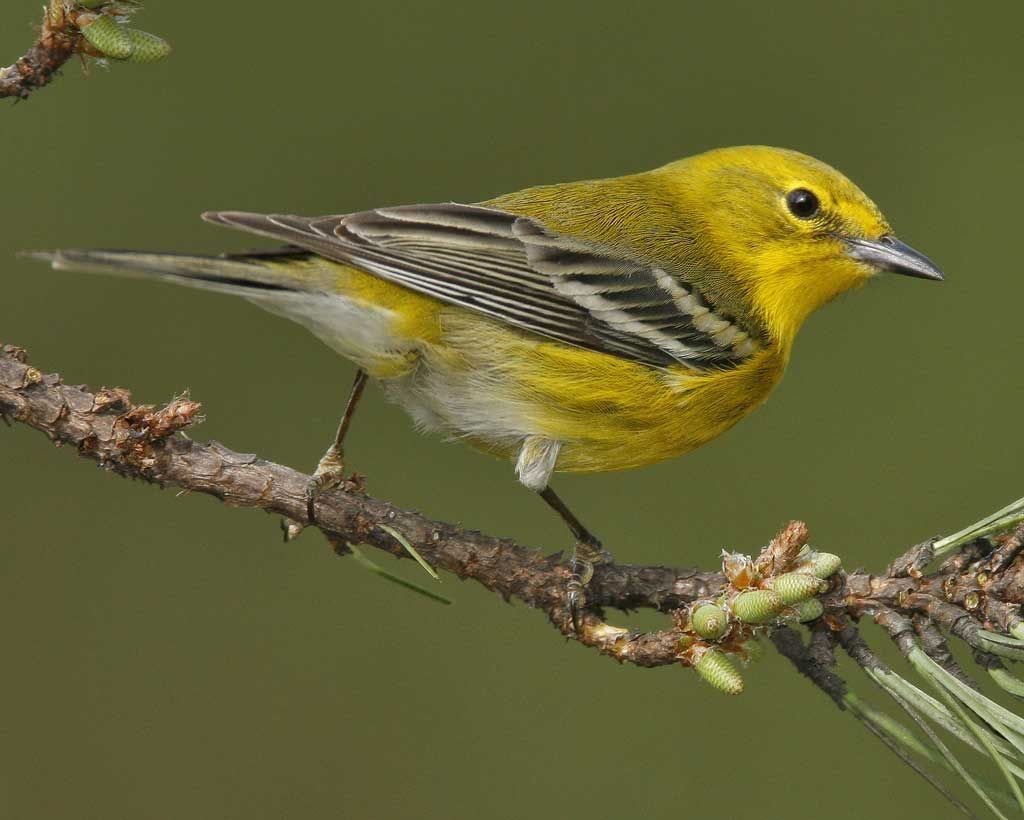
Pine Warblers can be spotted in New York during the breeding season and are frequently seen from April to September. They are recorded in approximately 9% of summer checklists.
These warblers have olive-green plumage, with yellow underparts that become brighter in males during the breeding season. They have thin beaks and can often be found in pine trees, as their name suggests.
Setophaga pinus
Length: 4.7-5.5 inches (12-14 cm)
Weight: 0.3-0.4 ounces (9-11 g)
Wingspan: 7.5-8.7 inches (19-22 cm)
Pine Warblers breed in eastern North America, from Canada to the southern United States. They prefer pine forests and are often found in the upper canopy of these trees.
You can find Pine Warblers foraging for insects, especially caterpillars, spiders, and beetles. They also consume pine seeds during winter.
Pine Warbler Song:
Credit: Andrew Spencer, XC676667. Accessible at www.xeno-canto.org/676667.
Nests of Pine Warblers are typically built in pine trees, where the female constructs a cup-shaped nest using twigs, grass, and pine needles. The nests are lined with softer materials such as feathers and moss. They lay around four eggs, which take about two weeks to hatch. The young birds stay in the nest for another two weeks before fledging.
To attract Pine Warblers to your backyard, provide bird feeders with suet, mealworms, and pine seeds. Planting pine trees and creating a habitat with dense foliage will also make your yard more appealing to them.
Fun Fact: Pine Warblers are known for their unique habit of drumming on tree trunks during courtship displays.
12. Blue-winged Warbler
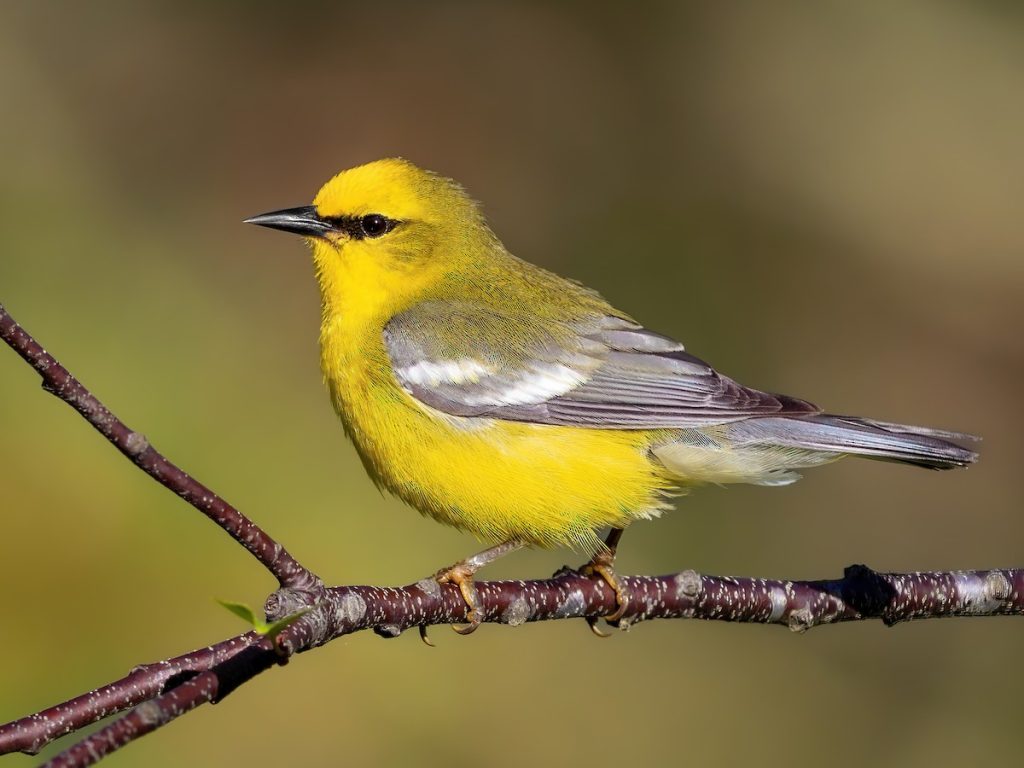
Blue-winged Warblers are observed in New York during the breeding season and can be seen mainly from April to September. They are recorded in approximately 6% of summer checklists.
These small warblers have bright yellow plumage with bluish-gray wings. Males have a black eye-line that distinguishes them from females, who exhibit a lighter eye-line or lack it altogether.
- Vermivora cyanoptera
- Length: 4.3-4.7 inches (11-12 cm)
- Weight: 0.3-0.4 ounces (7-11 g)
- Wingspan: 6.7-7.5 inches (17-19 cm)
Blue-winged Warblers breed in eastern North America, from the Great Lakes region to the southern United States. They prefer open habitats such as shrubby fields, young forests, and regenerating areas.
You can find Blue-winged Warblers foraging for insects, including beetles, flies, and caterpillars, in shrubs and lower branches of trees.
Blue-winged Warbler Song:
Credit: Russ Wigh, XC620094. Accessible at www.xeno-canto.org/620094.
Nests of Blue-winged Warblers are built on the ground, typically concealed in grass or vegetation. The female constructs a cup-shaped nest using grass, leaves, and bark strips, and lines it with fine materials. They lay around four to six eggs, which take approximately two weeks to hatch. The young birds leave the nest within ten to twelve days.
To attract Blue-winged Warblers to your backyard, create shrubby habitats with open spaces and provide a water source. Avoid using pesticides, as these can be harmful to both the warblers and their insect prey.
Fun Fact: Blue-winged Warblers often hybridize with Golden-winged Warblers, resulting in unique hybrid species known as Brewster’s Warbler and Lawrence’s Warbler.
13. Nashville Warbler
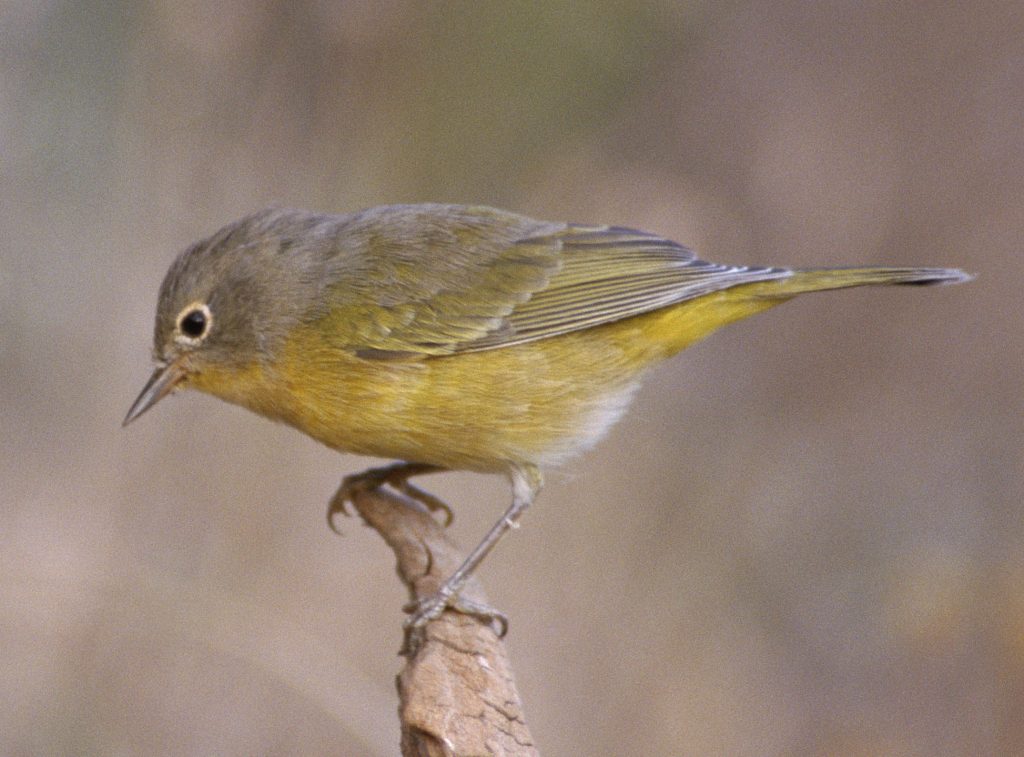
Nashville Warblers can be spotted in New York during migration, with their peak occurrence in May and September. They are recorded in up to 5% of checklists during these periods.
These small warblers have olive-green upperparts and a bright yellow throat and chest. They have a white eye-ring and a grayish head.
- Leiothlypis ruficapilla
- Length: 4.3-4.7 inches (11-12 cm)
- Weight: 0.3-0.4 ounces (8-12 g)
- Wingspan: 6.7-7.5 inches (17-19 cm)
Nashville Warblers breed in the boreal forests of Canada and Alaska. During migration, they pass through the eastern and central parts of the United States.
You can find Nashville Warblers foraging for insects, including caterpillars, beetles, and spiders, in shrubby areas and the lower branches of trees.
Nashville Warbler Song:
Credit: Peter Boesman, XC656557. Accessible at www.xeno-canto.org/656557.
Nests of Nashville Warblers are built on the ground or near the base of shrubs, using grass, moss, and other fine materials. The female constructs a cup-shaped nest and lines it with softer materials such as feathers and hair. They lay around four to five eggs, which require approximately twelve days to hatch. The young birds leave the nest within nine to twelve days.
Attracting Nashville Warblers to your backyard can be challenging, as they are primarily observed during migration. However, providing a diverse range of native plants and maintaining natural habitats can create a welcoming environment for these birds.
Fun Fact: Nashville Warblers were named after the city of Nashville, Tennessee, where the species was first collected by naturalist Alexander Wilson.
14. Yellow-throated Vireo

Yellow-throated Vireos can be observed in New York during migration, with their peak occurrence in May and September. They are recorded in approximately 5% of checklists during these periods.
These medium-sized songbirds have a yellow throat and underparts, with olive-green upperparts. They have a white eye-ring and two white wing bars.
- Vireo flavifrons
- Length: 5.5-6.3 inches (14-16 cm)
- Weight: 0.4-0.6 ounces (12-18 g)
- Wingspan: 9.1-10.6 inches (23-27 cm)
Yellow-throated Vireos breed in the southeastern United States and parts of Canada. During migration, they pass through the eastern and central regions of the United States.
You can find Yellow-throated Vireos foraging for insects, including caterpillars, beetles, and spiders, in deciduous forests and tree canopies.
Yellow-throated Vireo Song:
Credit: David M. Spector, XC614146. Accessible at www.xeno-canto.org/614146.
Nests of Yellow-throated Vireos are typically suspended from the forks of tree branches, constructed using plant fibers, grass, and bark strips. The female builds the nest and lines it with finer materials. They lay around three to five eggs, which require approximately two weeks to hatch. The young birds fledge within ten to twelve days.
To attract Yellow-throated Vireos to your backyard, maintain a diverse forest-like habitat with mature trees and provide a water source. Avoid using pesticides to protect their insect food sources.
Fun Fact: Yellow-throated Vireos have a distinctive call that sounds like they are repeatedly saying “You see it? You get it!”
15. Eastern Meadowlark
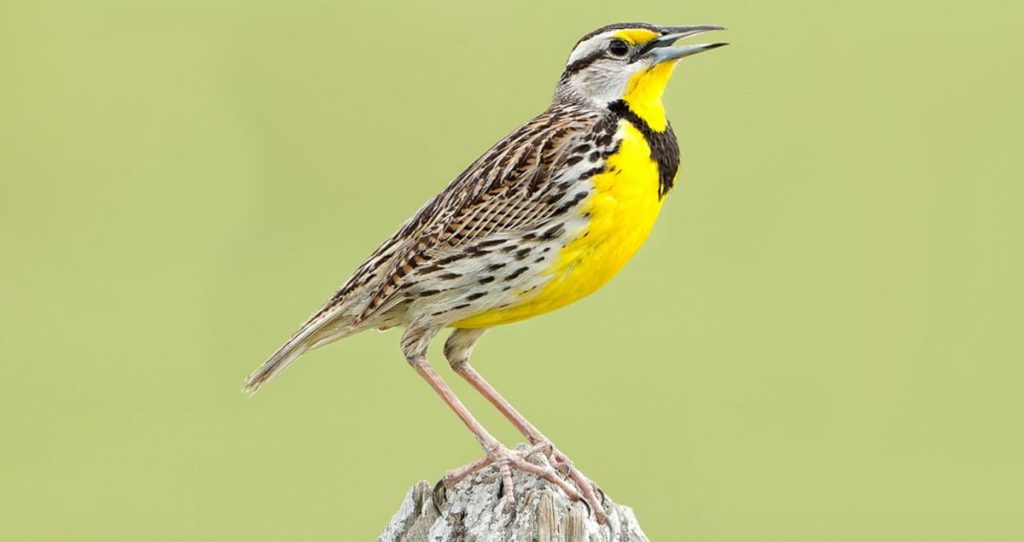
Eastern Meadowlarks are spotted in New York during the breeding season, with their peak occurrence from April to September. They are recorded in approximately 10% of summer checklists.
These medium-sized birds have a bright yellow chest with black V-shaped markings. They have a brownish back with streaks and a long, pointed bill.
- Sturnella magna
- Length: 7.5-10.2 inches (19-26 cm)
- Weight: 4.5-5.3 ounces (128-150 g)
- Wingspan: 14.6-16.9 inches (37-43 cm)
Eastern Meadowlarks breed in grasslands, meadows, and prairies across eastern North America. They are known for their melodious song, which consists of flute-like whistles.
You can find Eastern Meadowlarks foraging for insects, spiders, and seeds on the ground in open grassy areas.
Eastern Meadowlark Song:
Credit: Andrew Spencer, XC648454. Accessible at www.xeno-canto.org/648454.
Nests of Eastern Meadowlarks are built on the ground, concealed in tall grasses. The female constructs a cup-shaped nest using grasses and other plant materials. They lay around three to six eggs, which require approximately two weeks to hatch. The young birds leave the nest within ten to twelve days.
To attract Eastern Meadowlarks to your backyard, create open grassy areas with native grasses and maintain a natural habitat. Avoid using herbicides or pesticides, as these can harm their food sources.
Fun Fact: Eastern Meadowlarks have a unique habit of perching on fence posts or elevated areas to sing their melodious song, making them a familiar sight in open grasslands.
16. Prairie Warbler
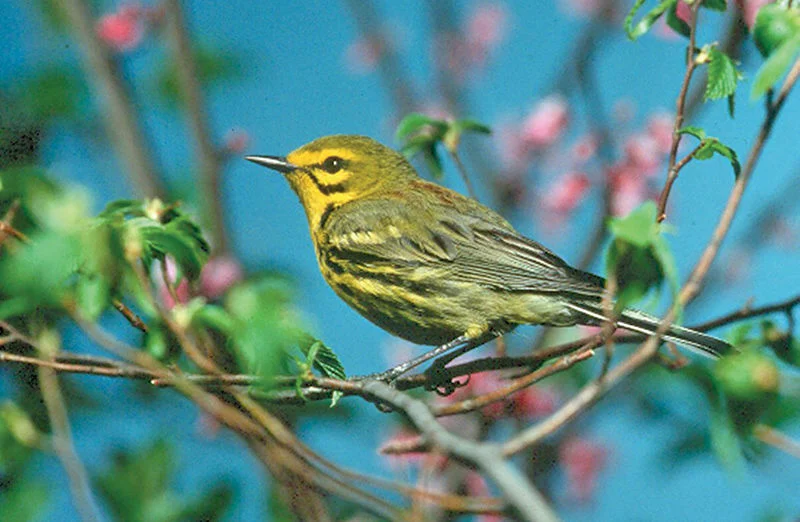
Prairie Warblers can be observed in New York during migration, with their peak occurrence in May and September. They are recorded in approximately 6% of checklists during these periods.
These small warblers have bright yellow underparts, olive-green upperparts, and black streaking on their sides. Males have bold black facial markings.
- Setophaga discolor
- Length: 4.3-4.7 inches (11-12 cm)
- Weight: 0.3-0.4 ounces (8-11 g)
- Wingspan: 6.7-7.5 inches (17-19 cm)
Prairie Warblers breed in grasslands, shrubby areas, and young forests across eastern North America. They prefer habitats with open spaces and scattered trees.
You can find Prairie Warblers foraging for insects, including caterpillars, beetles, and spiders, in shrubs and low branches of trees.
Prairie Warbler Song:
Credit: Peter Boesman, XC612676. Accessible at www.xeno-canto.org/612676.
Nests of Prairie Warblers are built on or near the ground, often hidden among vegetation. The female constructs a cup-shaped nest using grasses, leaves, and bark strips. They lay around three to five eggs, which require approximately two weeks to hatch. The young birds leave the nest within ten to twelve days.
To attract Prairie Warblers to your backyard, create shrubby habitats with open spaces and provide a water source. Native plants that offer berries and insects will also make your yard more appealing to them.
Fun Fact: Prairie Warblers are one of the few warbler species that breed in grasslands, earning them their unique name.
17. Canada Warbler
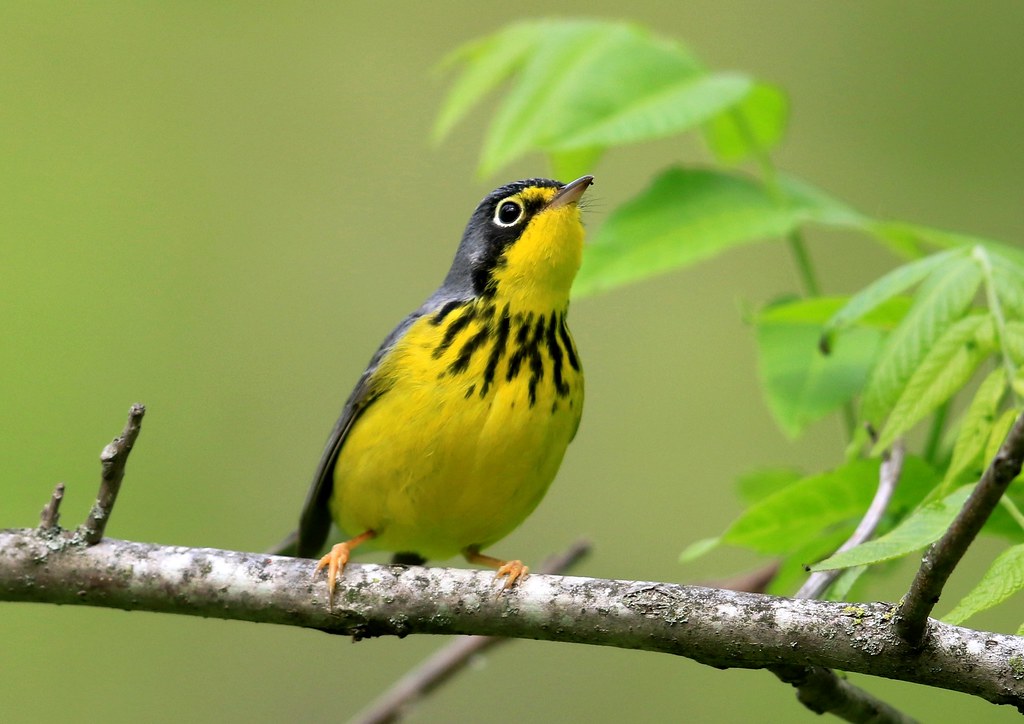
Canada Warblers can be spotted in New York during migration, with their peak occurrence in May and September. They are recorded in approximately 4% of checklists during these periods.
These small warblers have grayish-blue upperparts, bright yellow underparts, and a distinctive necklace of black streaks across their chests. Males have a black necklace that is bolder than females.
- Cardellina canadensis
- Length: 4.7-5.1 inches (12-13 cm)
- Weight: 0.3-0.4 ounces (9-12 g)
- Wingspan: 7.5-8.7 inches (19-22 cm)
Canada Warblers breed in boreal forests across Canada and northeastern United States. During migration, they pass through the eastern and central regions of the United States.
You can find Canada Warblers foraging for insects, especially caterpillars, in the understory of forests and dense shrubby areas.
Canada Warbler Song:
Credit: Paul Marvin, XC628457. Accessible at www.xeno-canto.org/628457.
Nests of Canada Warblers are built on or near the ground, concealed in vegetation or at the base of shrubs. The female constructs a cup-shaped nest using grasses, leaves, and moss, lined with finer materials. They lay around four to five eggs, which require approximately two weeks to hatch. The young birds leave the nest within ten to twelve days.
Attracting Canada Warblers to your backyard can be challenging, as they primarily pass through during migration. Creating a natural habitat with native shrubs and trees will provide suitable foraging areas during their stopovers.
Fun Fact: Canada Warblers are known for their unique migration pattern, as they undertake one of the longest nonstop flights of any migratory songbird, crossing the Gulf of Mexico in a single flight.
18. Hooded Warbler

Hooded Warblers can be observed in New York during migration, with their peak occurrence in May and September. They are recorded in approximately 5% of checklists during these periods.
These small warblers have bright yellow faces, underparts, and olive-green upperparts. Males have a bold black hood and bib-like markings, while females have a grayish hood.
- Setophaga citrina
- Length: 4.3-4.7 inches (11-12 cm)
- Weight: 0.3-0.4 ounces (9-11 g)
- Wingspan: 6.7-7.5 inches (17-19 cm)
Hooded Warblers breed in the eastern United States and parts of Canada. During migration, they pass through the eastern and central regions of the United States.
You can find Hooded Warblers foraging for insects, including caterpillars, spiders, and beetles, in shrubs and the lower branches of trees.
Hooded Warbler Song:
Credit: Lance A. M. Benner, XC116124. Accessible at www.xeno-canto.org/116124.
Nests of Hooded Warblers are typically built near the ground, concealed in thick shrubs or dense vegetation. The female constructs a cup-shaped nest using grasses, leaves, and bark strips, lined with fine materials. They lay around three to five eggs, which require approximately two weeks to hatch. The young birds leave the nest within nine to twelve days.
To attract Hooded Warblers to your backyard, create shrubby habitats with dense vegetation and provide a water source. Native plants that offer berries and insects will also make your yard more appealing to them.
Fun Fact: Hooded Warblers have a unique feeding behavior known as “gleaning,” where they search for insects and spiders among the foliage and branches of trees.
19. Orchard Oriole

Orchard Orioles spend the breeding season in New York and are mainly spotted from May to September. They are recorded in approximately 8% of summer checklists.
These small to medium-sized birds have bright yellow underparts and a black head and upperparts. Male Orchard Orioles have a chestnut coloration on their shoulders and rump, while females are olive-green with yellowish underparts.
- Icterus spurius
- Length: 6.7-7.5 inches (17-19 cm)
- Weight: 0.6-1.1 ounces (17-30 g)
- Wingspan: 9.8-11.8 inches (25-30 cm)
Orchard Orioles breed in open woodlands, orchards, and forest edges across eastern North America. They often choose habitats with fruit-bearing trees.
You can find Orchard Orioles foraging for insects, fruits, and nectar in the upper branches of trees and shrubs.
Orchard Oriole Song:
Credit: Andrew Spencer, XC682198. Accessible at www.xeno-canto.org/682198.
Nests of Orchard Orioles are built in the upper branches of trees, usually in deciduous trees such as maples and elms. The female constructs a woven pouch-shaped nest using grasses and plant fibers, lined with finer materials. They lay around three to five eggs, which require approximately two weeks to hatch. The young birds leave the nest within twelve to fourteen days.
To attract Orchard Orioles to your backyard, provide fruit-bearing trees and shrubs, such as mulberries, cherries, and serviceberries. Offering nectar feeders and maintaining a water source will also be appealing to them.
Fun Fact: Orchard Orioles are known for their beautiful and intricate woven nests, which often hang from the outer branches of trees like delicate pouches.
20. Blackburnian Warbler
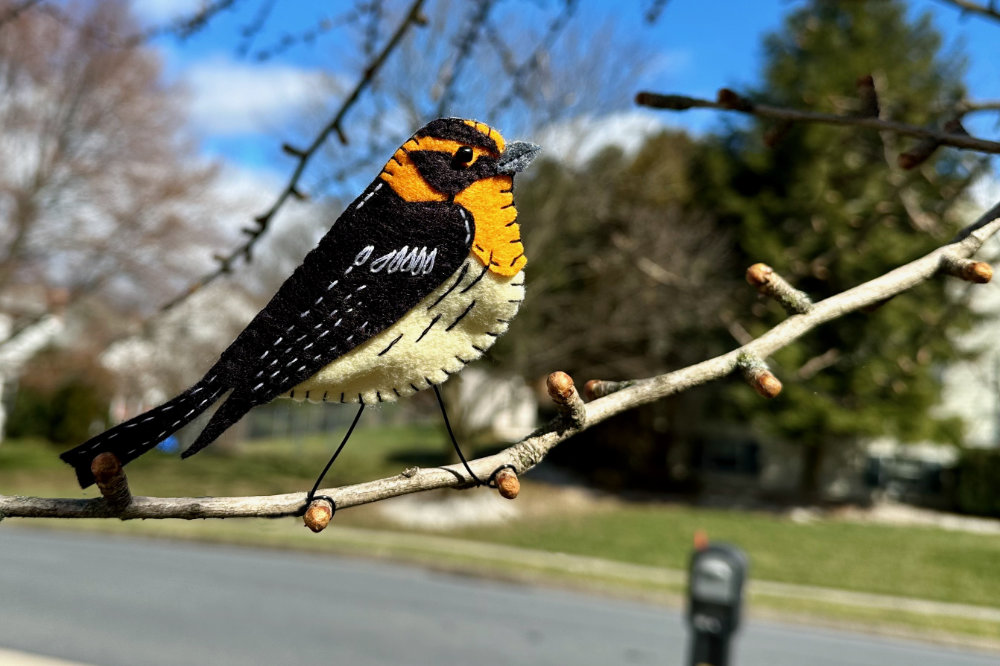
Blackburnian Warblers can be spotted in New York during migration, with their peak occurrence in May and September. They are recorded in approximately 4% of checklists during these periods.
These small warblers have a black upperparts and bright orange underparts, with a white wing patch. Males have a distinctive fiery orange throat, while females have a lighter yellow throat.
- Setophaga fusca
- Length: 4.3-4.7 inches (11-12 cm)
- Weight: 0.3-0.4 ounces (8-11 g)
- Wingspan: 6.7-7.5 inches (17-19 cm)
Blackburnian Warblers breed in coniferous and mixed forests across northeastern North America. During migration, they pass through the eastern and central regions of the United States.
You can find Blackburnian Warblers foraging for insects, including caterpillars, beetles, and spiders, in the upper canopy of trees.
Blackburnian Warbler Song:
Credit: Andrew Spencer, XC678251. Accessible at www.xeno-canto.org/678251.
Nests of Blackburnian Warblers are built on horizontal branches of coniferous trees, often near the trunk. The female constructs a cup-shaped nest using plant materials, bark, and spiderwebs, and lines it with fine materials. They lay around three to five eggs, which require approximately two weeks to hatch. The young birds leave the nest within nine to twelve days.
Attracting Blackburnian Warblers to your backyard can be challenging, as they primarily pass through during migration. Providing a variety of native trees and maintaining forest-like habitats will increase your chances of attracting them during their stopovers.
Fun Fact: Blackburnian Warblers have one of the longest migration routes of any North American warbler, traveling from their breeding grounds in northeastern North America to their wintering grounds in the Andes Mountains of South America.
21. American Goldfinch

American Goldfinches spend the breeding season in New York and can be seen from April to September. They are recorded
in approximately 62% of summer checklists.
These small songbirds have bright yellow plumage, black wings with white wing bars, and a black cap on the males during the breeding season. Females have a more subdued coloration, with olive-brown plumage.
- Spinus tristis
- Length: 4.3-5.1 inches (11-13 cm)
- Weight: 0.4-0.7 ounces (11-20 g)
- Wingspan: 7.5-8.7 inches (19-22 cm)
American Goldfinches breed across North America, including New York, and are known for their vibrant yellow plumage during the summer months.
You can find American Goldfinches foraging for seeds from plants such as thistles, sunflowers, and dandelions. They are often seen feeding on the flowers and seed heads.
American Goldfinch Song:
Credit: Andrew Spencer, XC686663. Accessible at www.xeno-canto.org/686663.
Nests of American Goldfinches are built in shrubs or trees, usually placed at the end of branches for added protection. The female constructs a cup-shaped nest using plant fibers, grasses, and spider silk, and lines it with softer materials. They lay around three to seven eggs, which require approximately two weeks to hatch. The young birds leave the nest within twelve to seventeen days.
To attract American Goldfinches to your backyard, provide nyjer (thistle) seed feeders and native plants that produce seeds and attract insects. They are particularly fond of coneflowers, sunflowers, and thistles.
Fun Fact: American Goldfinches are one of the few bird species that undergo a complete molt, changing their plumage from bright yellow in summer to a duller olive-brown in winter.
22. Yellow Warbler
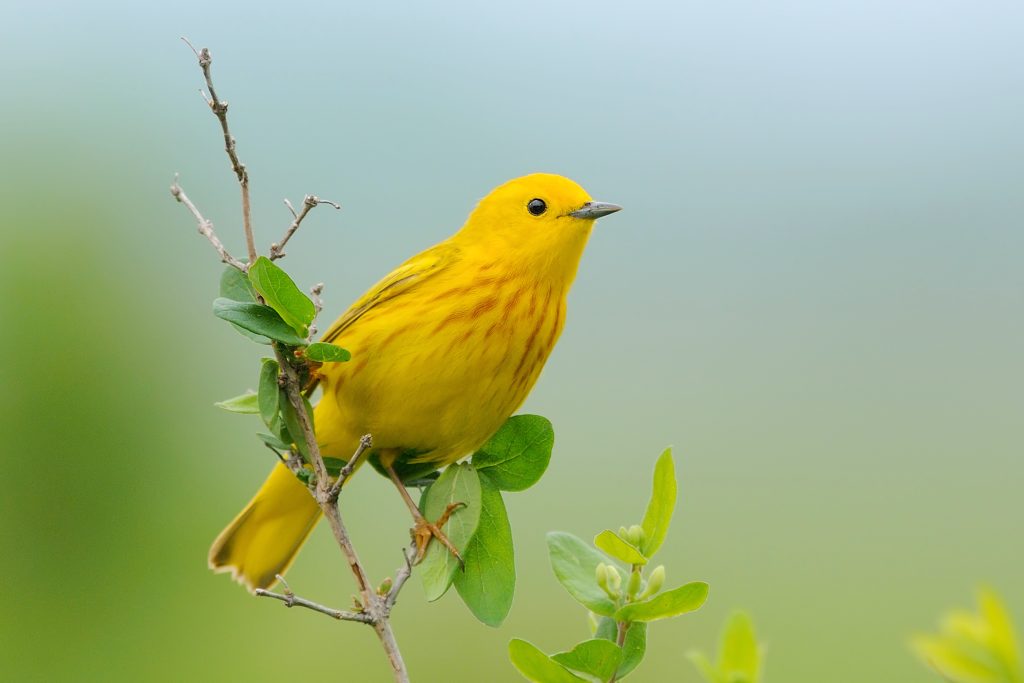
Yellow Warblers spend the breeding season in New York and can be seen from April to September. They are recorded in approximately 58% of summer checklists.
These small songbirds have bright yellow plumage, with males exhibiting reddish streaks on their chest during the breeding season. They have a slender build and a pointed beak.
- Setophaga petechia
- Length: 4.7 inches (12 cm)
- Weight: 0.3-0.4 ounces (8-11 g)
- Wingspan: 7.5 inches (19 cm)
Yellow Warblers breed across North America, including New York, and are known for their sweet and musical songs.
You can find Yellow Warblers foraging for insects, including caterpillars, beetles, and spiders, in shrubs and the upper branches of trees.
Yellow Warbler Song:
Credit: Andrew Spencer, XC674556. Accessible at www.xeno-canto.org/674556.
Nests of Yellow Warblers are cup-shaped and built in shrubs, trees, or even hanging plants. The female constructs the nest using plant fibers, grasses, and spider silk, and lines it with softer materials. They lay around three to six eggs, which require approximately ten to eleven days to hatch. The young birds leave the nest within eight to ten days.
To attract Yellow Warblers to your backyard, create a diverse habitat with shrubs, trees, and a water source. Planting native species that produce berries and attract insects will also be beneficial.
Fun Fact: Yellow Warblers are known for their long-distance migration, traveling from their breeding grounds in North America to their wintering grounds in Central and South America.
23. Prothonotary Warbler
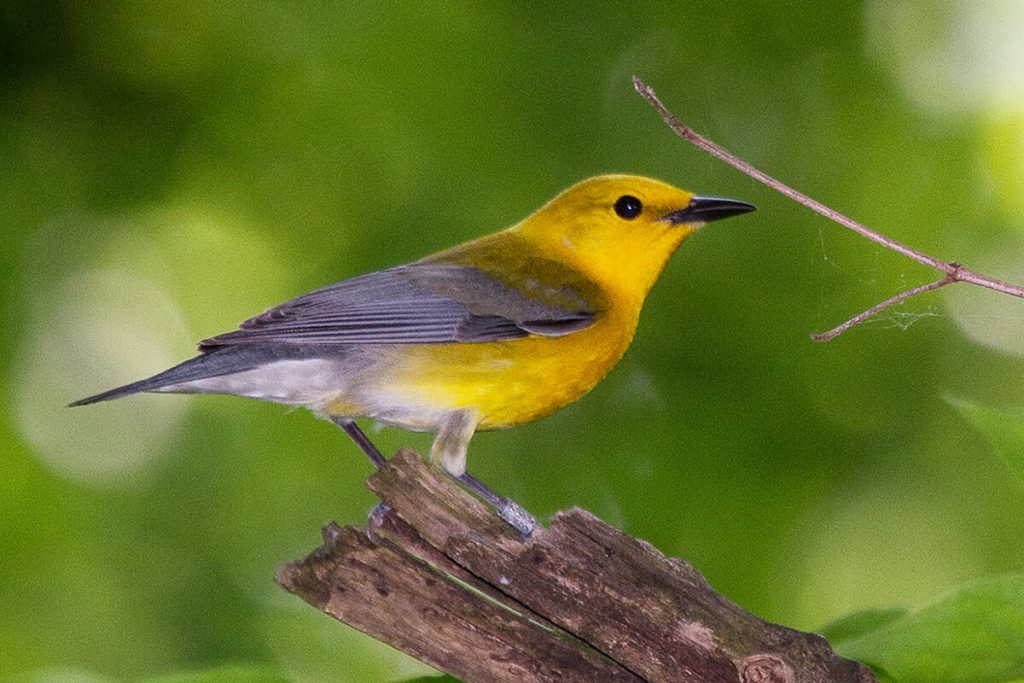
Prothonotary Warblers can be observed in New York during migration, with their peak occurrence in April and September. They are recorded in approximately 4% of checklists during these periods.
These small warblers have bright yellow plumage, with a bluish-gray back and wings. They have a relatively large and round head.
- Protonotaria citrea
- Length: 4.3-5.1 inches (11-13 cm)
- Weight: 0.4-0.5 ounces (12-14 g)
- Wingspan: 7.5-8.7 inches (19-22 cm)
Prothonotary Warblers breed in wet bottomland forests and swampy areas across the southeastern United States. During migration, they pass through the eastern and central regions of the United States.
You can find Prothonotary Warblers foraging for insects, including beetles, flies, and spiders, near the water’s edge or in low vegetation.
Prothonotary Warbler Song:
Credit: Lance A. M. Benner, XC139401. Accessible at www.xeno-canto.org/139401.
Nests of Prothonotary Warblers are built in tree cavities, often near water bodies. The female constructs a cup-shaped nest using plant fibers, leaves, and moss, lining it with softer materials. They lay around four to seven eggs, which require approximately twelve days to hatch. The young birds leave the nest within twelve to fourteen days.
To attract Prothonotary Warblers to your backyard, provide nest boxes near water sources such as ponds or streams. Planting native trees and shrubs near water bodies will create suitable habitat for them.
Fun Fact: Prothonotary Warblers are sometimes called “Golden Swamp Warblers” due to their vibrant yellow plumage and preference for swampy habitats.
24. American Redstart

American Redstarts spend the breeding season in New York and can be seen from April to September. They are recorded in approximately 32% of summer checklists.
These small warblers have black upperparts, bright orange patches on their wings and tail, and white underparts. Males have more extensive black markings, while females have grayish upperparts.
- Setophaga ruticilla
- Length: 4.3-4.7 inches (11-12 cm)
- Weight: 0.3-0.4 ounces (8-11 g)
- Wingspan: 6.7-7.5 inches (17-19 cm)
American Redstarts breed across eastern North America, including New York, and are known for their active and flickering behavior.
You can find American Redstarts foraging for insects, including caterpillars, beetles, and flies, in the upper canopy of trees and shrubs.
American Redstart Song:
Credit: Andrew Spencer, XC674515. Accessible at www.xeno-canto.org/674515.
Nests of American Redstarts are built in shrubs or the lower branches of trees, often near water sources. The female constructs a cup-shaped nest using plant fibers, leaves, and spider silk, lining it with finer materials. They lay around three to five eggs, which require approximately ten to twelve days to hatch. The young birds leave the nest within eight to ten days.
To attract American Redstarts to your backyard, create a diverse habitat with trees, shrubs, and a water source. Providing a variety of insect-attracting plants and avoiding the use of pesticides will also be beneficial.
Fun Fact: American Redstarts are known for their unique hunting strategy called “flush-pursuit,” where they rapidly open and close their wings to startle and flush out insects, making them easier to catch.
25. Yellow-breasted Chat
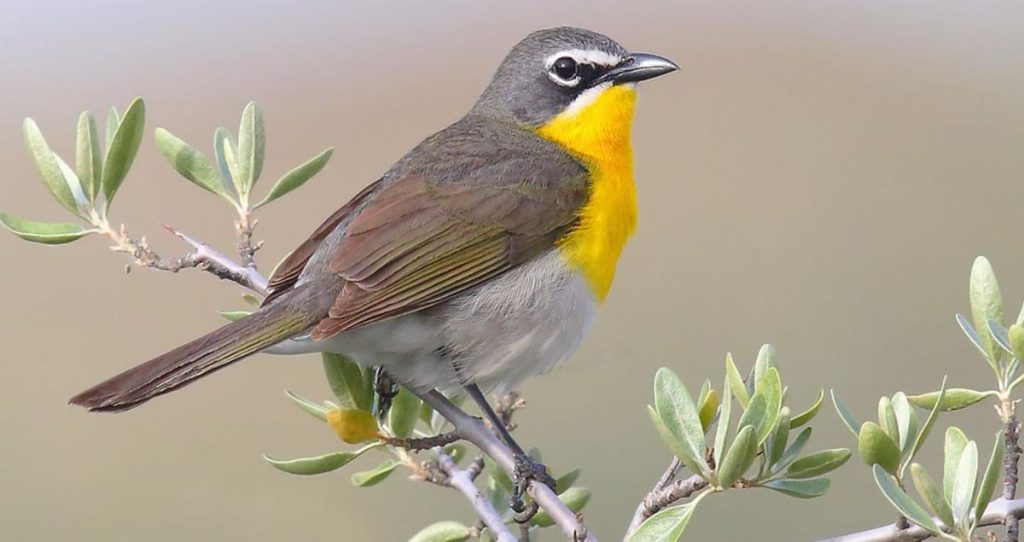
Yellow-breasted Chats can be observed in New York during migration, with their peak occurrence in May and September. They are recorded in approximately 3% of checklists during these periods.
These
large songbirds have a grayish-brown back, a bright yellow breast, and a distinct white eye-ring. They have a chunky build and a relatively long tail.
- Icteria virens
- Length: 7.5-7.9 inches (19-20 cm)
- Weight: 0.9-1.1 ounces (26-30 g)
- Wingspan: 9.8-10.2 inches (25-26 cm)
Yellow-breasted Chats breed in shrubby habitats, wetlands, and thickets across central and eastern North America. During migration, they pass through the eastern and central regions of the United States.
You can find Yellow-breasted Chats foraging for insects, including beetles, grasshoppers, and caterpillars, in dense vegetation and shrubby areas.
Yellow-breasted Chat Song:
Credit: Andrew Spencer, XC684911. Accessible at www.xeno-canto.org/684911.
Nests of Yellow-breasted Chats are typically built near the ground, concealed in dense vegetation. The female constructs a cup-shaped nest using plant fibers, grasses, and other materials, lining it with softer materials. They lay around three to six eggs, which require approximately twelve to thirteen days to hatch. The young birds leave the nest within eleven to thirteen days.
Attracting Yellow-breasted Chats to your backyard can be challenging, as they primarily pass through during migration. Creating dense shrubby habitats with diverse vegetation will increase the likelihood of attracting them during their stopovers.
Fun Fact: Yellow-breasted Chats are known for their complex and varied vocalizations, which include a mix of whistles, clucks, and squawks, often resembling the sounds of other birds.
26. Common Yellowthroat
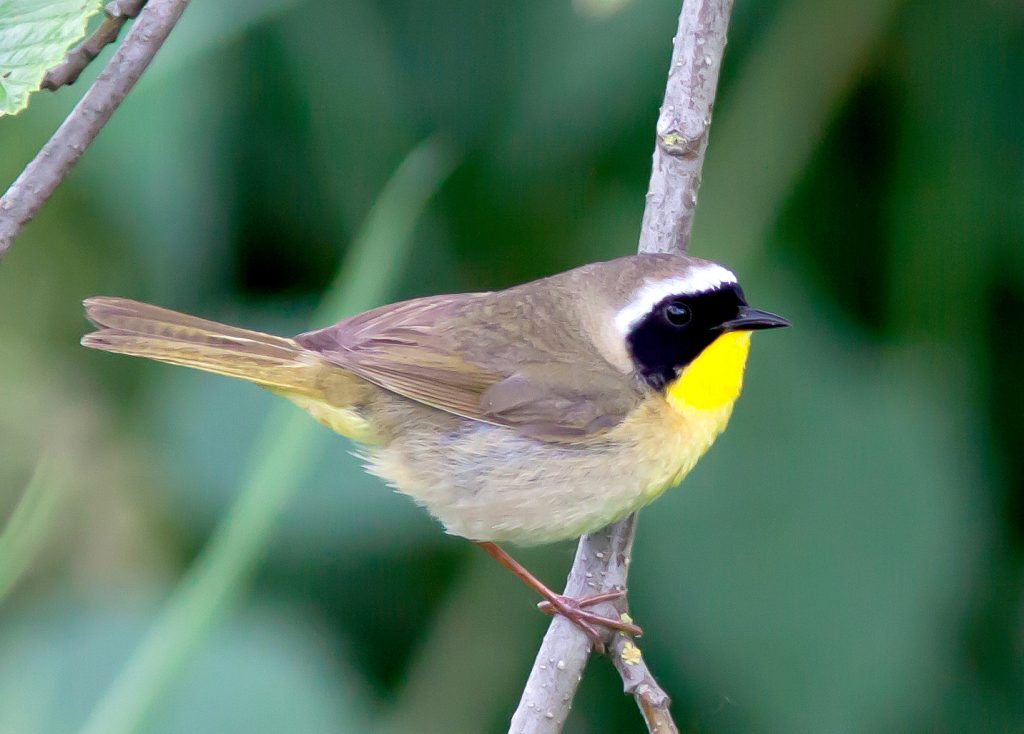
Common Yellowthroats spend the breeding season in New York and can be seen from April to September. They are recorded in approximately 47% of summer checklists.
These small warblers have olive-green upperparts, bright yellow underparts, and a distinctive black mask across their face. Males have a more extensive black mask than females.
- Geothlypis trichas
- Length: 4.3-5.1 inches (11-13 cm)
- Weight: 0.3-0.4 ounces (8-12 g)
- Wingspan: 6.7-7.9 inches (17-20 cm)
Common Yellowthroats breed across North America, including New York, and are known for their “witchety-witchety-witchety” song.
You can find Common Yellowthroats foraging for insects, including beetles, spiders, and caterpillars, in dense vegetation and shrubby areas.
Common Yellowthroat Song:
Credit: Andrew Spencer, XC676525. Accessible at www.xeno-canto.org/676525.
Nests of Common Yellowthroats are built on or near the ground, concealed in thick vegetation. The female constructs a cup-shaped nest using plant fibers, grasses, and other materials, lining it with finer materials. They lay around three to seven eggs, which require approximately ten to twelve days to hatch. The young birds leave the nest within eight to twelve days.
To attract Common Yellowthroats to your backyard, create dense shrubby habitats with varied vegetation. Offering a water source and avoiding the use of pesticides will also be beneficial.
Fun Fact: Common Yellowthroats are one of the most widespread and abundant warbler species in North America, found in a variety of habitats from wetlands to woodlands.
27. Hooded Warbler
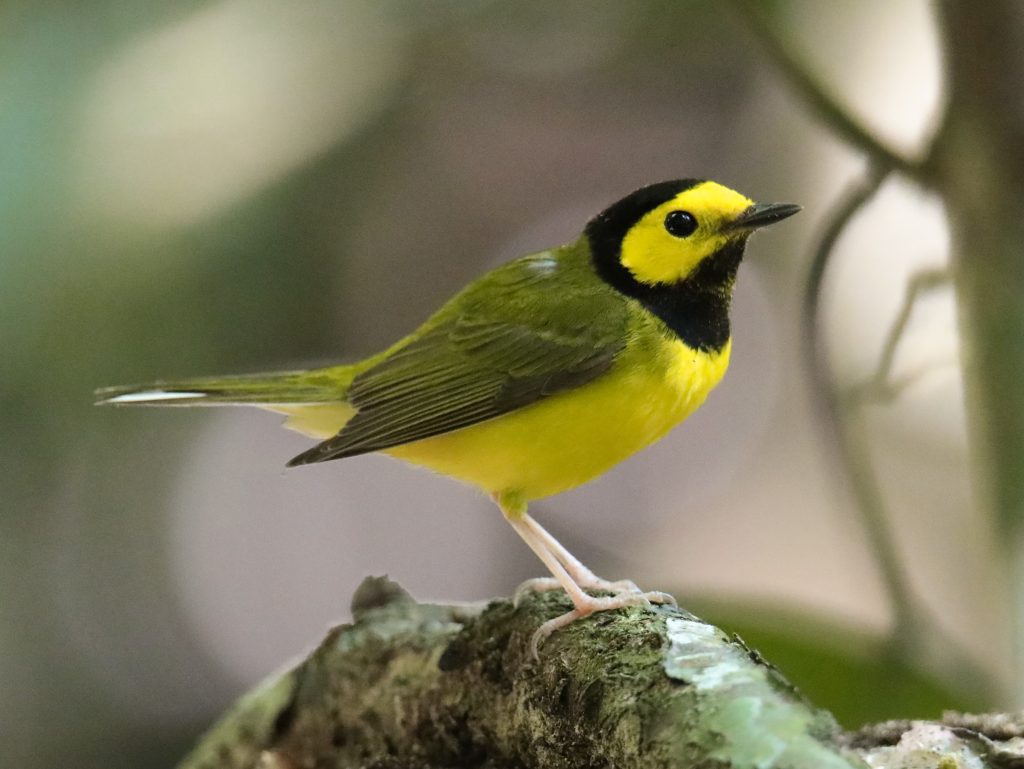
Hooded Warblers can be observed in New York during the breeding season, with their peak occurrence from May to September. They are recorded in approximately 7% of summer checklists.
These small warblers have a black hood covering their head and throat, contrasting with their bright yellow face and underparts. They have a thin black band across their chest.
- Setophaga citrina
- Length: 4.3-5.1 inches (11-13 cm)
- Weight: 0.3-0.4 ounces (8-11 g)
- Wingspan: 6.7-7.5 inches (17-19 cm)
Hooded Warblers breed in the eastern United States, including New York, and are known for their unique song, which resembles the sound of a ventriloquist.
You can find Hooded Warblers foraging for insects, including caterpillars, beetles, and spiders, in the understory of deciduous forests.
Hooded Warbler Song:
Credit: Ted Floyd, XC522598. Accessible at www.xeno-canto.org/522598.
Nests of Hooded Warblers are built on or near the ground, typically concealed in leaf litter or shrubby vegetation. The female constructs a cup-shaped nest using plant fibers, leaves, and other materials, lining it with finer materials. They lay around three to five eggs, which require approximately ten to eleven days to hatch. The young birds leave the nest within eight to ten days.
To attract Hooded Warblers to your backyard, create suitable understory habitat with shrubs and dense vegetation. Providing a water source and planting native trees and shrubs will also be beneficial.
Fun Fact: Hooded Warblers are known for their “ventriloquist” behavior, where their song seems to come from different locations, tricking listeners into searching for multiple birds.
28. Wilson’s Warbler
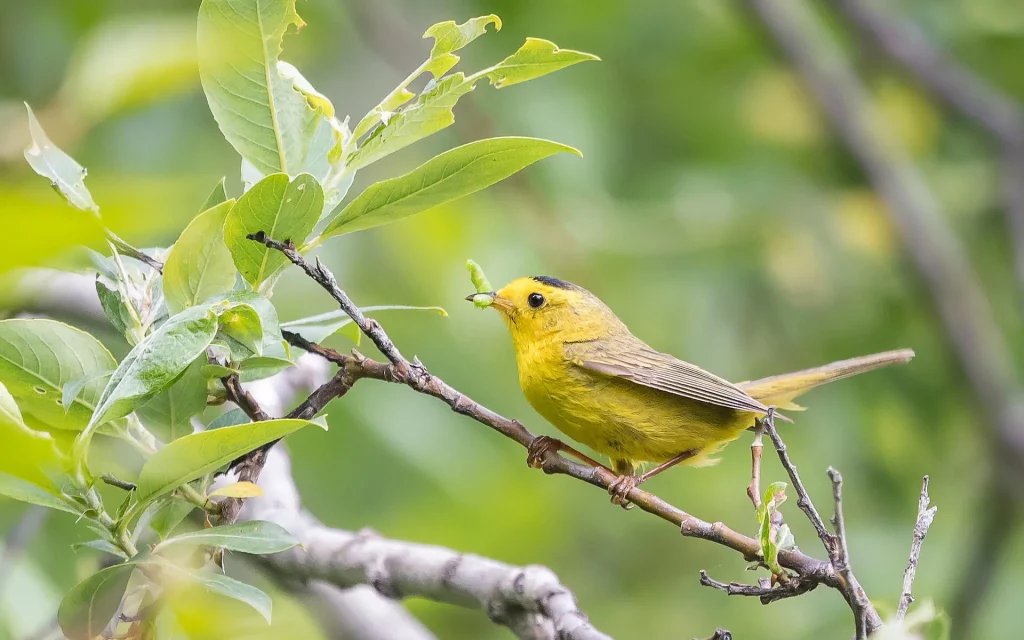
Wilson’s Warblers can be spotted in New York during migration, with their peak occurrence in May and September. They are recorded in approximately 5% of checklists during these periods.
These small warblers have bright yellow plumage, with olive-green shading on their back. They have a distinct black cap on the males, while females have a lighter crown.
- Cardellina pusilla
- Length: 4.3-4.7 inches (11-12 cm)
- Weight: 0.2-0.3 ounces (5-8 g)
- Wingspan: 6.3-6.7 inches (16-17 cm)
Wilson’s Warblers breed in coniferous forests across western North America. During migration, they pass through the western and central regions of the United States.
You can find Wilson’s Warblers foraging for insects, including beetles, flies, and caterpillars, in low vegetation and shrubby areas.
Wilson’s Warbler Song:
Credit: Andrew Spencer, XC619644. Accessible at www.xeno-canto.org/619644.
Nests of Wilson’s Warblers are cup-shaped and built close to the ground, often concealed in dense vegetation. The female constructs the nest using plant fibers, grasses, and other materials, lining it with finer materials. They lay around three to six eggs, which require approximately ten to twelve days to hatch. The young birds leave the nest within eight to ten days.
Attracting Wilson’s Warblers to your backyard can be challenging, as they primarily pass through during migration. Creating a diverse habitat with native plants that provide food and cover will increase the chances of attracting them during their stopovers.
Fun Fact: Wilson’s Warblers are known for their frequent tail-wagging behavior, which adds to their lively and energetic appearance.
29. Orange-crowned Warbler
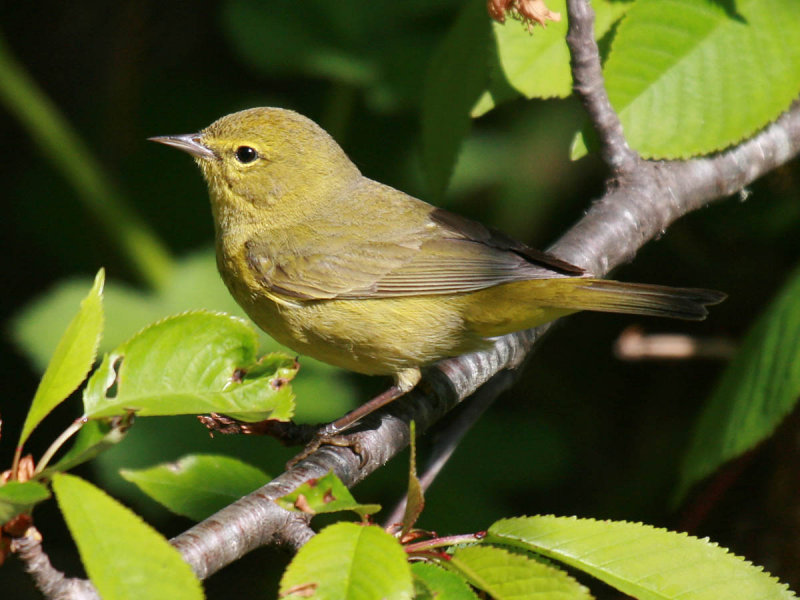
Orange-crowned Warblers can be observed in New York during migration, with their peak occurrence in May and October. They are recorded in approximately 2% of checklists during these periods.
These small warblers have olive-green plumage with a yellowish undertone. They have a relatively plain appearance and lack the distinct orange crown that may only be visible in certain lighting conditions.
- Leiothlypis celata
- Length: 4.3-5.1 inches (11-13 cm)
- Weight: 0.3-0.4 ounces (8-11 g)
- Wingspan: 6.7-7.5 inches (17-19 cm)
Orange-crowned Warblers breed in the western United States and Canada. During migration, they pass through the western and central regions of the United States.
You can find Orange-crowned Warblers foraging for insects, including spiders, caterpillars, and beetles, in shrubby areas and the lower branches of trees.
Orange-crowned Warbler Song:
Credit: David Vander Pluym, XC548623. Accessible at www.xeno-canto.org/548623.
Nests of Orange-crowned Warblers are cup-shaped and typically built close to the ground, hidden in dense vegetation. The female constructs the nest using plant fibers, leaves, and other materials, lining it with finer materials. They lay around three to six eggs, which require approximately twelve to thirteen days to hatch. The young birds leave the nest within nine to eleven days.
Attracting Orange-crowned Warblers to your backyard can be challenging, as they primarily pass through during migration. Creating shrubby habitats and offering water sources will increase the likelihood of attracting them during their stopovers.
Fun Fact: Orange-crowned Warblers are often considered the “little brown job” of the warbler family due to their plain appearance and subdued coloring.
So there you have it, a guide to 29 yellow birds in New York! Whether you’re a bird enthusiast or simply enjoy observing the beauty of nature, these vibrant and diverse species are a sight to behold. Happy birdwatching!
Discovering the Frequency of Yellow Avians in Summer and Winter Seasons in New York
In the realm of avian enthusiasts, checklists prove to be invaluable tools when determining the prevalence of various bird species within your region. These meticulously curated records present a comprehensive overview of the frequency with which yellow-feathered birds grace the checklists on ebird during the summer and winter seasons in the state of New York.
Yellow Birds in the Summer Skies of New York:
The charismatic American Goldfinch reigns supreme at an impressive rate of 44.7%. Not far behind, the enchanting Yellow Warbler claims a notable 33.5% presence, while the delightful Common Yellowthroat follows closely at 32.8%. Other vibrant species also make appearances, such as the Baltimore Oriole at 28.3%, the graceful Cedar Waxwing at 20.0%, and the captivating American Redstart at 17.5%. The Yellow-rumped Warbler brings its cheerful charm to the mix, making up 12.7% of the recorded sightings, with the Scarlet Tanager close behind at 10.8%. Further down the list, the Black-throated Green Warbler exhibits its brilliance at 8.3%, accompanied by the striking Magnolia Warbler at 7.4%. The Blue-winged Warbler proudly flaunts its vibrant hues at 5.9%, while the mellifluous notes of the Yellow-throated Vireo grace the airwaves, accounting for 4.9% of sightings. Lesser-seen yet equally captivating species include the Nashville Warbler at 4.1%, the Pine Warbler and Prairie Warbler, both at 3.6%, and the Orchard Oriole and Hooded Warbler, each contributing 3.0%. An assortment of avian beauties, such as the Palm Warbler at 2.9%, the Canada Warbler at 2.9%, and the Eastern Meadowlark at 2.6%, add a touch of splendor to New York’s vibrant summer landscapes. The Cape May Warbler and Wilson’s Warbler make fleeting appearances at 1.8% each, while the White-eyed Vireo gracefully presents itself at 1.0%. Rarer still, the Prothonotary Warbler seizes attention at a mere 0.3%, followed closely by the elusive Summer Tanager and Evening Grosbeak, each at 0.2%. The Dickcissel, Orange-crowned Warbler, and Yellow-throated Warbler are spotted in small numbers at 0.1%, collectively adding to the tapestry of avian diversity.
Yellow Birds Amidst the Winter Chill in New York:
During the winter months, the American Goldfinch maintains a steadfast presence, albeit at a slightly reduced rate of 24.1%. A resilient few persist through the cold, including the Yellow-rumped Warbler at 2.2% and the Cedar Waxwing at 1.9%, brightening the wintry landscapes. Sporadic yet delightful sightings come from the Evening Grosbeak at 0.5% and the Eastern Meadowlark at 0.2%, while the Orange-crowned Warbler, Baltimore Oriole, Pine Warbler, and Palm Warbler grace the observer’s eye at 0.1% each. The Common Yellowthroat, Dickcissel, and Wilson’s Warbler make more fleeting appearances at less than 0.1%, accompanied by the elusive Nashville Warbler, Yellow Warbler, Summer Tanager, American Redstart, Yellow-throated Warbler, Cape May Warbler, White-eyed Vireo, Prothonotary Warbler, Black-throated Green Warbler, Prairie Warbler, Magnolia Warbler, Hooded Warbler, and Scarlet Tanager, all adding a touch of mystique and rarity at less than 0.1%. The delicate balance of nature during winter allows only the most resilient yellow-feathered inhabitants to grace New York’s landscapes, painting a picture of serene beauty amidst the frosty atmosphere.
